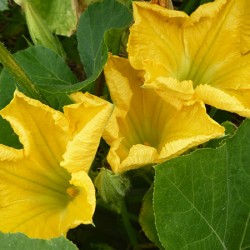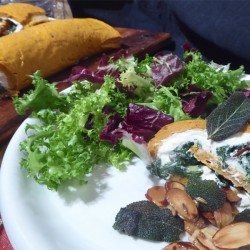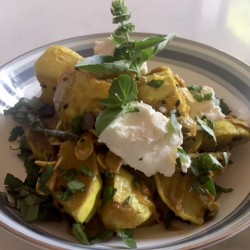Squash

Botanical name:
Cucurbita pepo
Description:
Squash is a member of the gourd family. The plant has tendrils and is a climbing vine. The vines grow up to 15 meters long, they produce anchoring roots that only root down superficially. The leaves are palmate and up to 40 cm wide. The stems of the plant are hollow and ridged and have a prickly surface. The flowers are yellow and up to 15 cm in diameter. They show 5 petals. Squashes are fertilised by insects. Squashes produce male and female flowers on the same plant.
There are hundreds of varieties of edible squash, varying widely in colour and shape. They are classified as summer and winter squashes. Summer squashes are harvested at immature state, whereas winter squashes are harvested after maturity. The name “summer squash” refers to the short storage life of these squashes, unlike that of winter squashes that can be stored for months.
Since summer squashes are harvested immature their flesh is less dense and offers less carbohydrates. Their skin is soft and edible. They are similar to a zucchini.
What’s a squash and what’s a pumpkin?
There is no botanical difference between a squash and a pumpkin. In the US the term squash is used for the whole family, while the big orange hard winter squash is called a pumpkin.
In Australia all these vegetables are called pumpkins when mature. We use the term squash when referring to summer squash, particularly to the small flattish yellow patty pan.
How to grow:
Squash like plenty of sun. The soil temperature needs to be higher than 16 C. Sow in well drained soil, enriched with compost. Sow seeds 4 cm deep. Space seeds 60 cm apart. Three to four plants per bed are plenty.
Fertilise with liquid fertiliser every fortnight from Summer.
Squash likes consistent watering. Make sure you keep the leaves dry when watering to avoid mildew.
8 to 10 weeks to the first harvest.
Squash need to be harvested frequently to encourage more flowers and fruit. Harvest small (up to 15 cm diameter) fruit as summer squash or leave on the vine to grow into a bigger pumpkin.
Growing in the neighbourhood:
Companions are beans, peas, nasturtiums and lovage.
Pests and other problems and how we deal with them:
Weak squash plants are prone to get powdery mildew. Make sure that air can dry the leaves by cutting out surplus growth. Remove all leaves that don’t look healthy. Early onset of mildew can be easily contained with a milk spray.
Season:
Early Spring to end of Summer
Seed-saving:
Squash cross pollinates with other plants of the gourd family. In order to collect true seeds the mother-plant would need to be kept isolated.
How to harvest and use:
Harvest squash when 5 to 15 cm in diameter, so the skin is still tender and doesn’t need peeling for use like a zucchini, or harvest mature squash for use like a pumpkin.
Squash can be fried, baked or roasted. If grown to a mature plant they can be used to make a soup, or hollowed out and stuffed. Squash flowers can be stuffed and deep fried or baked.
Gourd family
Botanical name Cucurbitaceae also known as cucurbits Features of gourds Plants of the gourd family are summer crops. They grow as vines or shrubs and have a hollow five ridged stem. Their up to 50 cm big leaves are palmate with 3 to 5 lobes. Leaves, stems, and fruit are often prickly. The stems develop [more]
Pumpkin and Goat’s Cheese Roulade
6 portions 1 kg butternut pumpkin (any pumpkin will do) olive oil 1 pinch of chilli flakes 2 cloves of garlic 60 g whole peeled almonds 1 teaspoon fennel seeds 6 large free-range eggs 80 g Parmesan cheese 60 g plain flour 5 pinches of grated nutmeg 300 g silver beet 100 g crumbly goat’s [more]
Pumpkin Pie
EASY PUMPKIN PIE By Kevin Hall 2 sheets frozen shortcrust pastry. 2 ¼ cups cooked mashed pumpkin Roasted is best. 395 gm can sweetened condensed milk. 2 tbsp cornflour. 2 eggs. ½ tsp ground cinnamon ½ tsp ground nutmeg ½ tsp mixed spice METHOD Heat oven to 180* C. Line a 25cm pie dish with [more]
Pumpkin Scones
Ingredients 1 tablespoon butter 1⁄2 cup sugar 1⁄4 teaspoon salt 1 egg 1 cup mashed pumpkin (cold) / 750grams Steam until cooked but still firm. Place in warm oven to dry out. 2 cups self-raising flour Directions Beat together butter, sugar and salt with electric mixer. Add egg, then pumpkin and stir in the flour until just combined. Turn on to [more]
Squash with cardamom & nigella seeds
Mary Ann Grant (inspired by Yotam Ottolenghi) Ingredients 20g unsalted butter 1 tbsp olive oil 1 large red onion, peeled, halved and cut into 1cm-thick slices (170g) Squash or pumpkin (about 1.2kg), peeled and cut into 3cm chunks 30g pumpkin seeds 1¼ tsp nigella seeds 1 tsp ground cumin 1 tsp ground coriander ¼ tsp ground [more]




